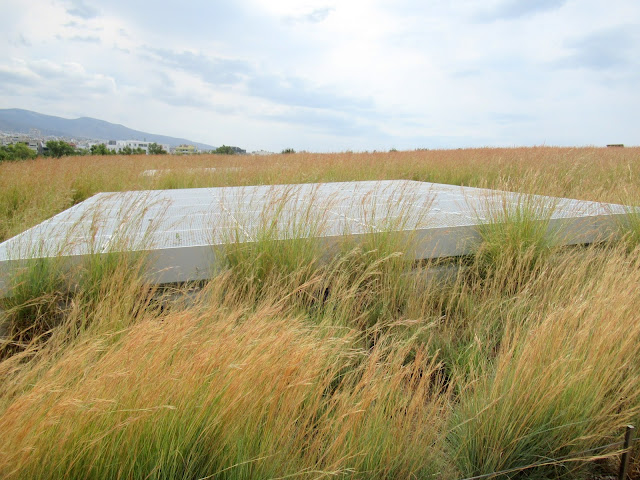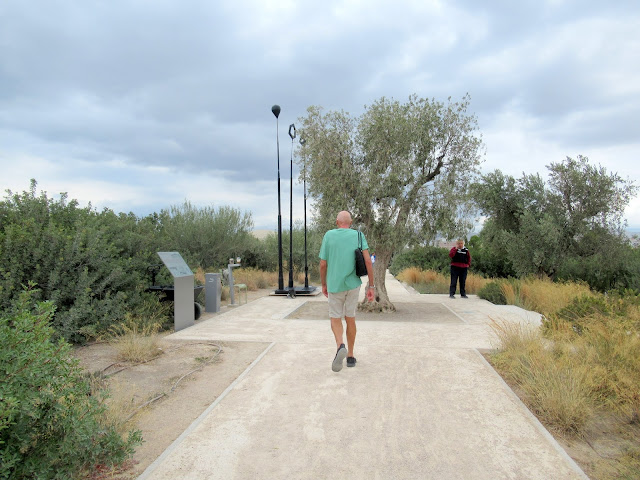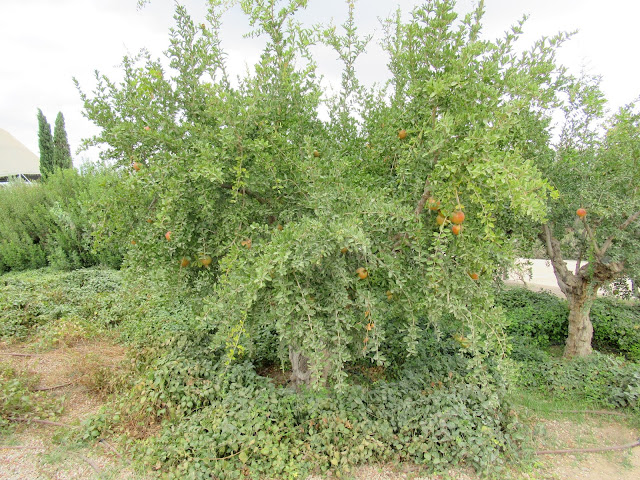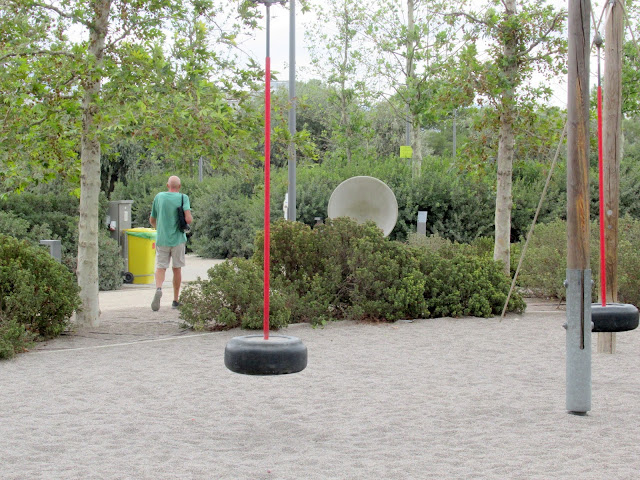Takis - Cosmos in Motion

at the Niarchos Cultural Centre.
A double pleasure: seeing 46 sculptures by Takis as well as visiting this iconic building and its wonderful park. We had a wonderful day. If you want to find out more about the building go
here and
here
We entered the building and moved on to the Agora
the national library on our right. If you want to learn more about the library go
here
We walked along the reflecting pool
and half-way along, across the water, we could see two of Takis' sculptures
Panayiotis Vassilakis - known by the nickname Takis - became one of the most original artistic voices in Europe in the 1960s. He remains a ground-breaking artist today. Born in 1925 in Athens, the self-taught artist began by studying ancient sculpture before moving in a radically new direction. During WWII, Takis was active in the Resistance in occupied Greece and faced political persecution during the Greek Civil War that followed. To escape the stifling political climate and pursue his artistic career, he moved from Athens to Paris in 1954. While living in Paris in the mid-1950s, he started exploring the sculptural possibilities of electromagnetism. For Takis the 'visual qualities' of his work were irrelevant. 'What I was obsessed with was the concept of energy'.
Looking back at the reflective pool and the building in the distance.
At the other end of the reflective pool, three more sculptures.
In 1959, Takis made a leap from figurative art to a new form of abstraction, based on magnetic energy. He suspended metal objects in space using magnets, giving lightness and movement to what is usually gravity-bound and still. He was fascinated by the waves of invisible energy that he saw as 'a communication' between materials. Art critic Alan Jouffron described these works as 'telemagnetic'. 'Tele' meaning 'at a distance', suggests their relationship to technologies such as television and telephone.
Throughout the 1960s and 1970s Takis incorporated radar, antennae, aerials, dials and gauges into his sculptures. Although he approached these materials with knowledge about engineering and science, he consistently defined himself as an artist geared towards mythological thought. In his hands, technologies of warfare e and environmental destruction became monuments of beauty and contemplation: 'My desire as a sculptor was to learn to use this energy, and through it, to attempt to penetrate cosmic mysteries', he explained.
He produced various 'telemagnetic' installations in the early 1960s using plinths, walls and the ceiling of the gallery. The installations challenged the traditional conventions of sculpture. Waves of magnetic energy move through these spaces, holding the individual elements in suspension.
Aeolian, 2000, (painted iron, aluminium)
Aeolian, 2000, (painted iron, aluminium)
Aeolian, 2000, (painted iron, alumiiium)
Early in his career, Takis began experimenting with how to use energy and movement in sculpture. 'What interested me was to put into iron sculpture a new, continuous and life force'... The result was in no way a graphic representation of a force but the force itself. Marcel Duchamp described Takis as 'the happy ploughman of the magnetic fields'.
At the end of the pool we turned left and entered the park.
This is a park for walking and enjoying. Wide avenues make walking easy whilst the planting is all around you
in this part of the park it's ancient olive trees
This path leads to the building and there was a group of Takis sculptures on our right
Photovoltaic Signals (painted iron, polystyrene, bronze, photovoltaic flashing light)
Aeolian Signal - Firework, 1957, (painted iron, aluminium)
Aeolian Signal - Firework, 1957, (painted iron, aluminium)
Flower, 1978, (painted iron, bronze)
Flower, 1976, (painted iron, bronze)
We could see another sculpture in the distance
Aeolian, 1986, (painted iron, polysterene)
We reached the paved path that leads to the top of the building which is perched above this 32 metre artificial hill
Grasses on either side of us, and the air vents reminding us that we were in fact walking on the roof of the building

Spheres - Mercury, Mars, Earth, Jupiter, Uranus, Saturn, Neptune (Iron, copper, painted iron, iron, inox, inox)
We had reached the top and if we looked back the view was spectacular: we could see Lycatettus Hill and the Acropolis - clearer once I zoomed in
We started walking around the roof of the building - this is the outdoor cinema area, they show films most evenings in the summer
We moved around to get some sea views which did not disappoint - the Floisvos Marina
Pireus
We did not linger but started walking towards the park again, as seeing the sculptures was the priority
We were not disappointed - three more ahead of us
Signals, 1979, (painted iron, bronze)
Takis' Signals resemble radio receivers. For him, they are 'like electronic antenna, like lightning rods... They constituted a modern hieroglyphic language'.
We had reached the side of the building
here, the park's irrigation system is very clear
Electric Barrels, 2012, (photovoltaic panel, electrical circuit, painted iron, lamps, battery)
Throughout our exploration I kept thinking that we must visit the park at night, as the illuminated sculptures must be stunning
another one in the distance
Aeolian, 1987, (painted iron, polysterene)
Spiral, 1986, (painted iron)
Spiral, 1986, (painted iron)
Signal - Archimedes Screw, 1972, (painted iron, bronze)
Lots of flowering plants and herbs here - I think this is a buddleia but I was not sure
flowering thyme - the scent was heavenly
a pomegranate tree
and two more
they're about to ripen and should be hitting the shops soon
This structure was apparently set up for a concert - no access when we visited which meant we could not go and see the labyrinth
an apple tree
very pretty
At first we thought that these mirrored cubes were some kind of art installation but they are the guards' huts, and they are dotted everywhere by the many entrances to the park
We arrived at the interactive part of the park - lots of different areas for kids to play
This is the standing sheep
the sheep that is resting is next to it
We reached the Parabolic Reflectors - there are three sets around the park
There are two in each group at a fair distance from each other - one of you stands by one and the other at the other one. You can talk to each other using a normal voice and the other person can hear you. Great fun
So, Ken walked to the far one and we had a conversation
These move so it's a great balance exercise as you step from one to the other
Lots of gigantic chess boards around
as well as smaller ones
getting ready to play
We got to the fountain which must be such fun in hot weather
the sign recommends wearing non-slip shoes when playing here
don't know what this lawned area is for but it was out of bounds for us
Another set of Parabolic Reflectors and we had another play
Ken managed to play
Twinkle, Twinkle, Little Star
Then, the Wind Pipes
The Turning Stone is always fun
as is the Ferrephone
Finally, we could not get this bench to play the Chopin music it's meant to.
We had seen and done everything, and it was time to go home. A great day.
If you want to read about Takis' exhibition at Tate Modern, you can see it
here



























































































